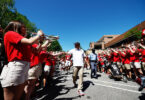“It’s not easy being green” is a frequent excuse for avoiding environmentally friendly products. But furnishings and interiors students are working with UGA architects to demonstrate that not only are “green” materials available, they’re also affordable.
Throughout this semester, the students have focused on an “eco-friendly” renovation of the Rogers Road family housing units.
“The education in this project goes both ways,” said Kevin Kirsche, assistant director of planning in the Office of University Architects. “The students got first-hand experience from professionals, especially with green products, but we also gained so much from them—unique ideas and a refreshing way to approach projects.”
“I wanted to make the students aware that there are sustainable solutions out there that are better for our environment and for future generations—especially in light of the water crisis,” said Margaret Woosnam, assistant professor of furnishings and interiors, who credited work by UGA’s Academy of the Environment for providing the impetus for the project.
The 30 seniors worked in groups, each redesigning a floor of the units.
“For the first time we’ve seen what it’s like to work with real limitations like minimal space, specific clients and a budget,” said Peyton Cheely. “Instead of having make-believe restrictions, this project trained us to work at our first job with the limitations that designers encounter.”
This “green flip,” as students are calling it, required them to find and incorporate the best green products at the lowest cost while trying to keep as many of the current items as possible.
“Many people don’t usually think about the waste that’s created with renovations,” Woosnam said. “The students were challenged to keep as much of the old items as possible in order to lessen the amount of waste in the landfills that many projects create.”
Although some groups elected to keep the original kitchen cabinetry and update it with a fresh coat of paint in order to minimize waste, when it came to the 1970s flooring and countertops, the students agreed that replacement was necessary.
“There’s a student in the class whose parents lived in the units. . . we were all surprised to learn that the vinyl flooring is the exact same,” Woosnam said.
Among their choices for replacement were tile floors made from recycled materials and countertops made from paper that resists mold and bacteria.
“The countertops definitely need to be replaced,” Cheely said. “They are covered in stains and have a funky smell that no one would want to cook on.”
“These students have done their research and have excelled,” Kirsche said. “They’ve really taken into consideration the lifestyle of the clients and have learned to prioritize the use of green products within the budget.”
The students also have the opportunity to become LEED accredited. The Leadership in Energy and Environmental Design program is an effort of the U.S. Green Building Council to provide a standard for environmentally sustainable construction.
“LEED-certified buildings are very popular right now, especially out West,” Lyz Breznik said. “But it’s moving from the ‘cool’ thing to do to a standard in design and construction all over the nation.”
During class time, students take practice exams to prepare for the LEED certification exam which will add extra credentials many young graduates don’t have.
“Students who pass the exam will stand out amongst other counterparts,” Woosnam said. “This certification will prepare them for other board exams as well as provide them a credential for a design method that the nation is taking hold of.”
Woosnam said she hopes future Rogers Road residents also will benefit from the new designs.
“Because there’s such a high turnaround of residents,” she said, “this project enables us to reach many people and hopefully each resident will take away a new and improved, environmentally friendly way to live.”







